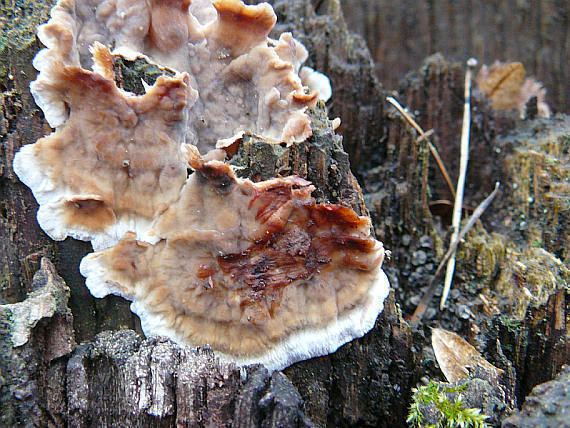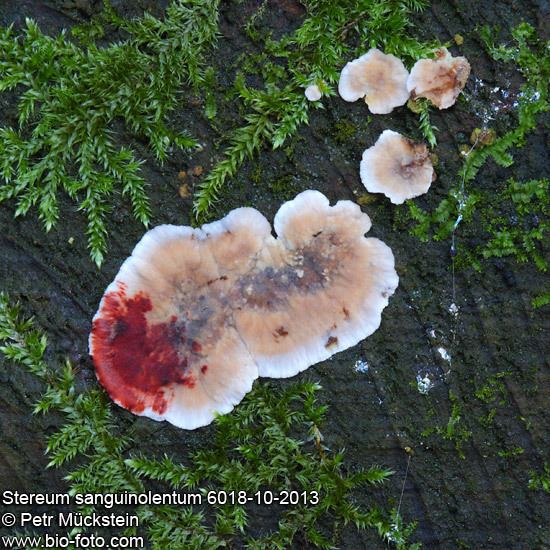Kingdom Fungi | Division Basidiomycota Genus Stereum Rank Species | |
Similar Stereum, Stereum rugosum, Stereum hirsutum, Stereum gausapatum, Tremella encephala | ||
Pevn k krvav j c stereum sanguinolentum
Stereum sanguinolentum is a species of fungus in the Stereaceae family. A plant pathogen, it causes red heart rot, a red discoloration on conifers, particularly spruces or Douglas-firs. Fruit bodies are produced on dead wood, or sometimes on dead branches of living trees. They are a thin leathery crust of the wood surface. Fresh fruit bodies will bleed a red-colored juice if injured, reflected in the common names bleeding Stereum or the bleeding conifer parchment. It can be the host of the parasitic jelly fungus Tremella encephala.
Contents
- Pevn k krvav j c stereum sanguinolentum
- Taxonomy
- Description
- Habitat distribution and ecology
- References

Taxonomy

The species was first described scientifically by Albertini and Schweinitz in 1805 as Thelephora sanguinolenta. Other genera to which it has been transferred throughout its taxonomical history include Phlebomorpha, Auricularia, Merulius, and Haematostereum. The fungus is commonly known as the "bleeding Stereum" or the "bleeding conifer parchment".
Description

The fruit body of Stereum sanguinolentum manifests itself as a thin (typically less than 1 mm thick) leathery crust on the surface of the host wood. Often, the upper edge is curled to form a narrow shelf (usually less than 10 mm thick). When present, these shelves are can be fused to or overlap neighboring shelves. The surface of the fruit body consists of a layer of fine felt-like hairs, sometimes pressed flat against the surface. The color ranges from beige to buff to dark brown in mature specimens; the margin are lighter-colored. Fresh fruit bodies that are injured exude a red juice, or will bruise a red color if touched. The fruit bodies dry to a greyish-brown color. The spores are ellipsoid to cylindrical, amyloid, and typically measure 7–10 by 3–4.5 µm.
Stereum sanguinolentum can be parasitized by the jelly fungus Tremella encephala.
Habitat, distribution, and ecology

The fungus causes a brown heart rot, resulting in wood that is a light brown to red-brown color, and dry, with a stringy texture. A cross-section of infected wood reveals a circular infection around the center of the log. It enter opens wounds of plants caused by mechanical damage or by grazing wildlife. Fragments of mycelia can be spread by wood wasps (genus Sirex). The rot spreads up to 40 cm (16 in) per year. It has also been recorded on balsam fir, Douglas fir, and western hemlock. The fungus is widespread in distribution, and has been recorded from North America, Europe, east Africa, New Zealand, and Australia.

